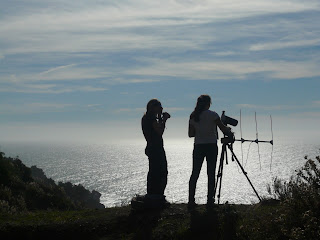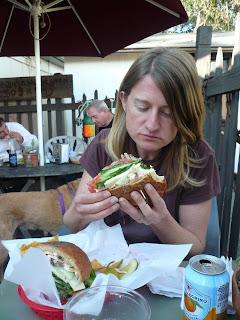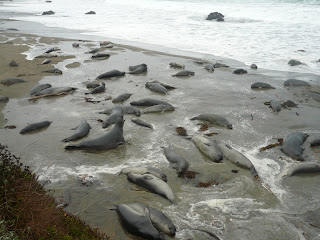Point Lobos State Reserve is a headland at Carmel just north of Big Sur and at the southern end of Monterey Bay. Their website has some great photoshttp://www.pointlobos.org/arts/photography
The headland is covered with Monterey pine and Monterey Cypress, one of only two native stands of Monterey cypress anywhere.
The rocks and trees have been sculpted by wind and sea and succulent plants grow in the cracks in the rock so it all looks very landscaped. There are sea otters, seals and a sea lion colony.
Three sea otters were bobbing around in the bay, the waves were pretty big, two had very young pups on their chests, a volunteer was on hand with a telescope so we could have a look but it was a bit seasick inducing. The population of sea otters in the Monterey area is decreasing, they have seen a high mortality rate in recent years and birth rates are not increasing. The Alaska sea otter population is doing much better, but maybe not for long (we have just found out about this http://www.facebook.com/l.php?u=http%3A%2F%2Forg2.democracyinaction.org%2Fo%2F6912%2Fp%2Fdia%2Faction%2Fpublic%2F%3Faction_KEY%3D8745&h=tAQF9IOiYAQGDV2VSEZFkXeZCK7CgW3mmjMDzKeFQ4EUgsA)
All were just about wiped out in as a result of years of harvesting for their fur and it is though all today's Californian population are from a remnant of around 20 individuals left in 1938, about 1000 were left in Alaska.
We think that this rock formation looked like a Pika
cool rock formation
there are sea lions on these rocks, but are zoom wasn't up to the job
The sea lion colony was all male, the females live in a similar colony further down the coast and they only meet once a year to breed. The rocks were covered in sealions, they weren't flat rocks either, we couldn't believe how well they could climb. We watched some climbing around over the rocks walking all over others that were asleep, they are better at going up than down as they don't have much control over speed or direction and just point their head down and slide, it looked painful. The best thing was watching sealions that were trying to get out of the sea onto the rocks. They bobbed around trying to time their jump with the huge waves that would lift them up into position but if they didn't jump in time they got bumped into the rocks on the way down. Some tried for ages and occasionally one would get onto an intermediate rock only to washed away a minute later, they were probably just enjoying it.
sandstone shapes
Sticky monkey flower - Mimulus aurantiacus
Sticky monkey Ralph with a Monterey cypress
Brown algae on the branches called trentepohlia http://en.wikipedia.org/wiki/Trentepohlia_(alga)
Succulents growing in among the rocks
sadly we didn't see any pigs

































































